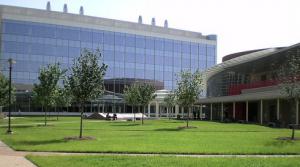STEM educationEnrollment in U.S. science and engineering graduate school increases
After remaining essentially flat for the past two years, the number of full-time graduate students enrolled in science and engineering (S&E) programs rose by 2.4 percent in 2013, to nearly 425,000 students. The increase was largely due to a 7.9 percent rise in full-time enrollment of foreign graduate students on temporary visas. Foreign enrollment hit an all-time high of 168,297 students in 2013, or 39.6 percent of the full-time S&E graduate student population—up from 35.9 percent in 2008.

Science and Engineering Research and Classroom Complex, University of Houston // Source: commons.wikimdia.org
After remaining essentially flat for the past two years, the number of full-time graduate students enrolled in science and engineering (S&E) programs rose by 2.4 percent in 2013, to nearly 425,000 students, according to a new InfoBrief from the National Science Foundation’s (NSF) National Center for Science and Engineering Statistics (NCSES).
NCSES found the increase was largely due to a 7.9 percent rise in full-time enrollment of foreign graduate students on temporary visas. Foreign enrollment hit an all-time high of 168,297 students in 2013, or 39.6 percent of the full-time S&E graduate student population—up from 35.9 percent in 2008.
The NSF says that in contrast, full-time enrollment for U.S. S&E graduate students fell for the third year in a row. But while overall enrollment by U.S. citizens and permanent residents declined, the number of U.S. students of Hispanic or Latino descent has climbed steadily since 2008, resulting in 25.8 percent in growth.
NCSES found that among U.S. graduate students, enrollment continued to become more diverse. Of the total students enrolled in S&E graduate programs:
- 8.9 percent were Asian and Native Hawaiian or Other Pacific Islanders
- 8.6 percent were Hispanic or Latino
- 8.1 percent were Black or African American
- 2.1 percent reported they were more than one race
- 0.6 percent were American Indian or Alaska Native
Those groups made up 28 percent of the total graduate enrollments in S&E, including U.S. and foreign students. In 2008, they accounted for less than a quarter of students who were U.S. citizens and permanent residents.
The study also found that a decade-long decline continued in postdocs conducting research in the sciences. Between 2010 and 2013, the number of postdocs in science fields dropped by 2.8 percent, with the largest decreases in the two biggest science fields: biological sciences and physical sciences. Over the same period, the number of postdocs in engineering fields rose by 2 percent, with the largest increases in chemical engineering, biomedical engineering and electrical engineering.
See more in the report Full-Time Graduate Enrollment in Science and Engineering Rose in 2013, Fueled by a Large Increase in Foreign Graduate Enrollment.
